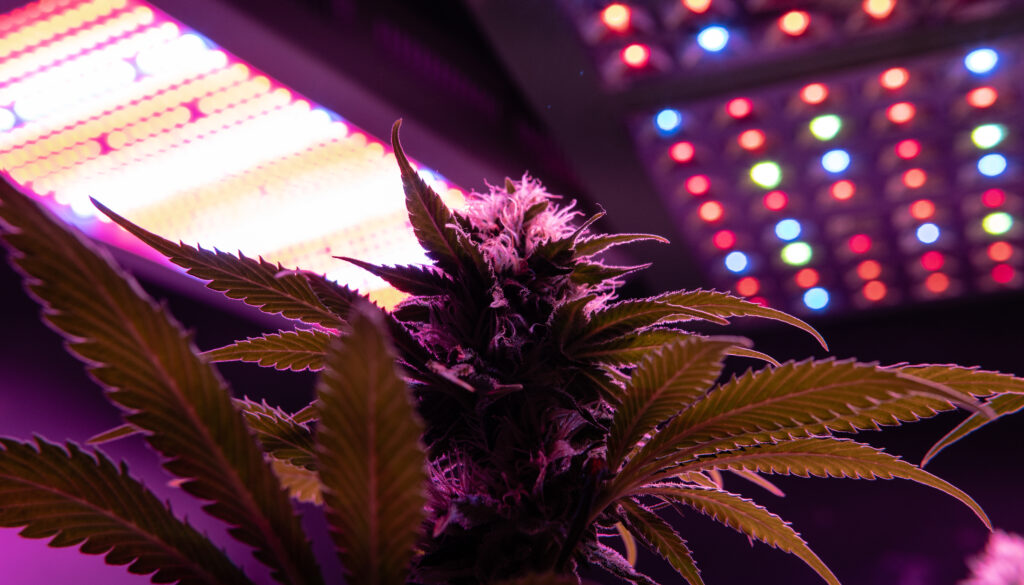
Features
Cultivation
Production
Key features to look for when purchasing LEDs, part two
Finding the right light to fit individual requirements
October 20, 2022 By Jonathan Fernandes
 Photo: Adobe Stock
Photo: Adobe Stock We are at the beginning of an exciting time in the global cannabis industry as we move from complete prohibition to establishing legal regimes for sales. This shift implies new opportunities and innovations, and with innovation comes the potential for growth, improvement and new learning curves.
A focus on LED lighting
In continuing with the previous post on cannabis lighting, in this article we will highlight some of the key features to look for when deciding on lights for indoor cultivation. This includes features of automation and control, output, and quality build.
Over the past three years our studies have shown that LED lighting could be the preferred lighting choice of cultivators. LEDs allow producers to program and control light quality to achieve optimal grow conditions and reduce costs.
Power output and efficacy features
As previously discussed, there are varied shapes and sizes of lights, but the most important feature of a light is the energy output and the efficacy of that output. Cannabis plants only focus on how much photosynthetically active radiation (PAR) is available in light to drive photosynthesis. PAR is measured by examining the photosynthetic photon flux (PPF), which is the available number of photons in µmol(micro-mol) per second from the light source.
The PAR can be measured in PPFD, the “D” being the density of the photons in µmol per meter squared, per second. PPFD can measure this using a quantum sensor/meter, not a light meter. PPF tells you how much energy is available, while the PPFD can tell you the amount of energy hitting your canopy.
The photosynthetic photon efficacy (PPE) tells you how efficiently that light is converting the input wattage into available light photons – it is the PPF divided by watts used and expressed in μmol·J (micro-mols/per joule).
An effective LED light should consistently feature an 850-1100 PPFD range at canopy’s height (cannabis can use more PAR depending on the genetics and if certain conditions are met). Moving the distance between the canopy height and the light source can affect the overall coverage area and PPFD.
Lighting efficacy has also improved dramatically with LEDs. Some high-end lights can reach the 3-4 μmol·J range, which can be highly effective in converting electricity into usable light photons. Having high efficacy is a feature that saves on electrical consumption and fugitive heat.
Coverage area and power requirements are part of the planning and research required when designing cultivation infrastructure. Power and efficacy are the features that tell you how much energy you have and are using to grow the crop. Using this knowledge in your planning helps to create a productive and efficient grow space.
Programable control features
Implementing features to control the light quality (intensity, duration, spectrum), could increase flower quality (yield, potency, structure). Light quality can trigger many different genetic expressions in cannabis, such as larger plants or varied terpene profiles.
If lighting “recipes” based on cultivar can be managed through a controller, you can access these changes instantly or remotely, initiating automation and data collection.
Controllers can have other features such as managing several lights or a whole room at once. With these features, growers can manage plants from seed to harvest, controlling both intensity and spectrum based on set times.
Dialling these functions remotely or through WIFI benefits off-site control. Controllers can also incorporate features that initiate fail-safe/shut off measures when a max temperature is reached, available through LED lights’ precision and control.
Quality build and parts
Features operate most effectively when built with quality parts and intuitive operations, also lending itself to longevity. Here, simplicity is key. Parts should be sturdy (especially hanging points) and easy to clean, for grow environments become full of dust, dirt and debris.
Features that support passive cooling and the use of heat dispersing materials are more desirable than fans and other moving parts needed to keep the fixture at optimal temperature.
Plug and play assembly is easier for setup and performing changes or repairs – the simpler the lighting unit, the easier it is to operate and maintain.
The high-end quality of diodes and higher efficacy rating indicate fixtures with longer warranties. Obviously, cheap diodes degrade faster.
In addition to diodes, electrical drivers used to convert the electricity to send power to the diodes must be efficient, create as little heat as possible, and have operational longevity. A light fixture that features quality parts will last longer and have a longer warranty.
Certifications, testing and ratings
While not specific features of a fixture, certifications, ratings and testing comprise the data that support the operational use of the light. LEDs are considered energy-efficient light sources that can accurately measure power/efficiency though testing and certification.
Having standards associated with lighting ensures a certified quality build, potentially qualifying for local rebates.
Many of these certifications, especially on the energy efficiency side of things, can assist you in accessing energy rebates from your local utility provider once you’ve made a purchase. There are many instances of appropriately tested and certified lights that can access more than 50 per cent of rebates from the retail price. This benefit makes it affordable to switch to new technology.
Founder and President of Green Amber Canada, Jonathan Fernandes is a cannabis creator experienced in farming, extraction, education and equipment design. With over 20 years in the Canadian legacy market, he aims to educate and support consumer needs. Prior to working in cannabis, Jonathan worked with the Ontario government. His experience in enforcement, policy and legislation development makes him a driving force for the evolving cannabis regulations. Currently he spends his time researching and developing cannabis lighting technology.
Print this page